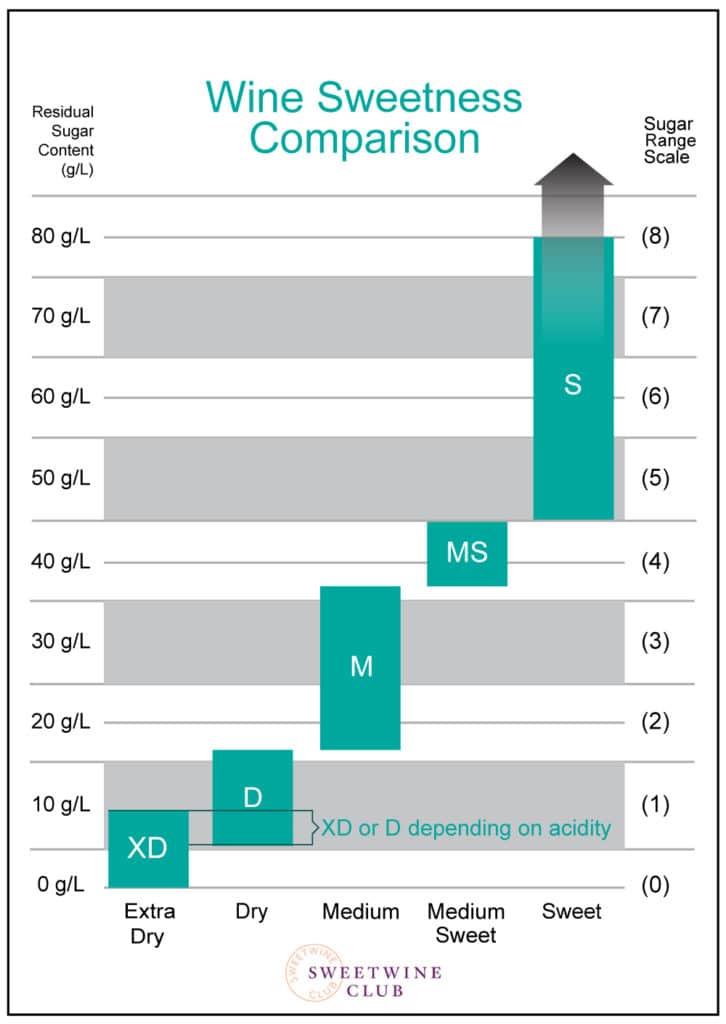Starting in the wine-tasting world can be challenging, especially if you don’t have someone to help you. The experience is very new, from different tastes, aromas to tongue-twisting pronunciations. My advice to a beginner is starting with something sweet that won’t trouble your palate. The beauty of sweet wine is that it doesn’t have that bitterness of coffee or hoppy beer and is very easy to drink.
Sweet wines are welcoming and are a good choice to introduce someone with the world of wine tasting. If you start with red wine, the high tannin content that comes with it may not be so welcoming and can repulse someone new. Just as everyone is different, so is every palate. You can’t be assured that a given wine will be agreeable to the other. However, in my experience, sweet wines are the best starting points, and they have more refinement than they are accredited for.
How is Wine categorized as Sweet?
What are sweet wines? The majority of beginners can’t differentiate between sweet and fruity wines. These terms are usually tossed around as wine drinkers try to understand what they mean. So, let me elucidate this thing. The sweetness in wine refers to the actual sugar levels left in a bottle of wine when fermentation is done. Many beginners confuse this sweetness for fruitiness. Wine can be dry, but still, taste sweet. How? Well, the sweetness that you get in dry wine is the fruity flavors and aromas that wine offers.
In the winemaking process, grapefruits are picked and then crushed to produce juice. The next process involves fermenting the juice to produce wine. This is where sugar from the grapefruits is used to turn the juice into wine. Moreover, The type of grape used or the level of fermentation reached to increase or reduce the sugar level can also influence the outcome of wine (dry or sweet). Dry wines have less than 1% residual sugar. For sweet wines, the residual sugar is above 20%. The length of time used in the fermentation process is the most significant determinant of whether wine is regarded as dry or sweet. Consider this wine sweetness chart for your reference.

Other Indicators of Sweet Wines
Other elements that contribute to wine taste to a beginner are alcohol content, body, and aromatics. The overall taste is also influenced by the technique used to ferment the juice or how long it is allowed to ferment. All these things adjusted and combined will decode sweet wine instantly.
Body
Body refers to the feel of wine when it enters your mouth. The alcohol content greatly affects the body of the wine. Lower alcohol content makes the wine light-bodied while high alcohol content makes the wine full-bodied or bold. What makes light-bodied wines favorable to beginners is the sweet taste that makes them easy to drink.
Alcohol Content
Generally, the alcohol content in wine falls between 5.5 percent and 23 percent ABV. Wines are categorized as sweet, if they have lower alcohol content and higher residual sugar content. Although there are several exceptions, this is what looked at most of the time.
Wine Aromatics
The smell that wine gives off when you smell it, is what called aroma. To get the wine’s aromas, lift the glass of wine to your lips and just pause for a while. The aromas that hit your sense is what you should fill in and try to guess what they smell like. A different wine will have different aromas and this mostly determined by how long the wine was aged. You will get that sweet sensation from sweet wine. This makes a glass of wine taste sweeter even if there is no sugar in it.
Sweet White Wines for Beginners
Generally, most sweet wines for beginners provide more sweetness than red wines, but this doesn’t mean that all white wines are sweet. Red wines are typically known for their bitterness which is not favorable to many beginners. Below are several sweet white wines out there. They range from dessert status to the only slightly sweet.
Moscato
Muscat is a sweet, slightly effervescent wine that is derived from a type of sparkling wine called Moscato d’Asti. This is a grape variety that is mostly grown in Italy’s Piedmont region. This white wine is light and fresh, filled with a blend of fruit flavors like pineapple, lime, pear, and orange. Often served with the dessert meal, Moscato is low in alcohol and on desserts it works great with apple or pear tarts. It also goes well with pastries, a buttery flavor or nuts. You can also pair this wine with spicier foods, light meat, chicken or seafood.
Tokaji
Funny how this Hungarian white wine gets its flavor from a fungus. Tokaji wines are very sweet and are rated by the level of residual sugar found in each bottle. It has notes of ginger, saffron, and beeswax. If you want to nail it on food pairing, you need to go for salty or savory meals rather than desert meals. The wine also works well with several kinds of cheese like Comte, blue cheese, brie or goat cheeses.
Riesling
This best sweet wine is grown in Germany in the Rhine region. It is awesomely loaded with several aromas that range from perfumed florals to apples, pears and peaches. Hailing from Germany, these white wines often work well with numerous Asian cuisines like Vietnamese, Thai and Indian foods.
Chenin Blanc
From Loire Valley of France, Chenin Blanc isn’t necessarily always sweet. However, it is usually considered a dessert wine. It has a notable acidity and a clear minerality with hints of honey. When it comes to food pairing, this wine matches with rich dishes since the acidity cuts through the fat. You can pair it with spicy cuisines, pork, and duck.
Sauternes
France is gifted with white wine, and Sauternes is one of them. Cultivated in the Bordeaux region, its sweetness is manifested by the effect of noble rot of the grave region. This wine has a slight nuttiness, with honey, peaches, and apricots combination. This sweet wine matches with fatty meats like veal, foie gras, salty hams, and foods with high spice content.
Sweet Red Wines for Beginners
This may seem to contradict those who are just delving into the world of wine, but it is not a sin to try it out. That is why I thought it best to mention these sweet red wines to help you get comfortable in the wine world.
Brachetto d’Acqui
Hailing from the Branchetto region of Italy, this is a sparkling red wine that is not so popular and is made from a light and refreshing red grape. It gets its red notes from all red-colored accents like strawberry, cherry, rose candy, violet, and raspberry. If you want to pair it with food, you can try out with flavors that match it, including strawberry shortcakes, raspberry tarts, peach or plum pies or chocolate hazelnut desserts.
Lambrusco
This is a fruity red wine from Emilia-Romagna, made from ten different grape types. It is a slightly sparkling wine with notes of raspberries, blackberries, cherry, and almond. You can pair it, almost all kinds of pork, lamb, and steak. Lambrusco best compliments with hard cheeses like parmesan and pecorino.
Dornfelder
This is medium-bodied sweet red, and is derived from German-crossed red wine grape varietal. This grape varietal is a prolific and relatively early ripening grape. For a typical red German wine, it produces wine far deeper in color. It has several tastes; from dry to sweet with aromas of cherries, fresh blackberry, and spiced herbs. When it comes to food painting, Dornfelder red wines match with roast meats, game dishes, and rich cheeses.
Black Muscat
This is a unique wine blend made from Muscat of Alexandria and Schiava grapes. It is a mixture of a medium-bodied wine with a hint of Moscato. It’s an earthy wine that features tasting notes of rose with a hint of sweet tea. You can pair it with milk or dark chocolate and desserts like chocolate mousse.
Schiava
Schiava is a great red wine from Northern Italy. Taking a sip, you will first consider it dry after that, it reveals sweet notes of cotton candy, rose, sweet cherry sauce, and cinnamon. Although it’s not easy to find, once found, it is worth it. To balance its sweet flavors, you can pair it with baked ham and cured meats like prosciutto or salami or cheeses like pecorino.
Final Choice Depends
Don’t undermine these sweet wines, just because it is meant for beginners. There is nothing wrong with them, and they are of high quality. It is just meant to give a new mouth a welcoming reception. Anyone can drink them, even those who have a good wine experience. However, as a beginner, you should not stop here, and you should keep on trying something new every time to gain new wine experience. So, Keep on exploring, the choice is all yours.
